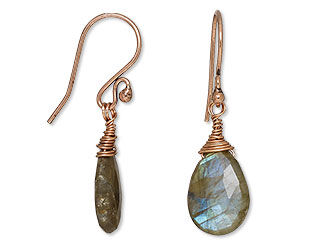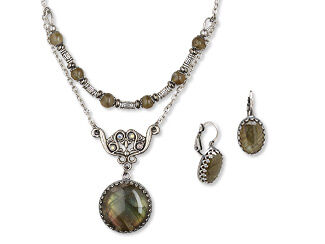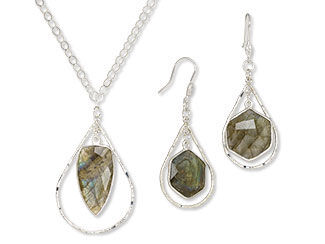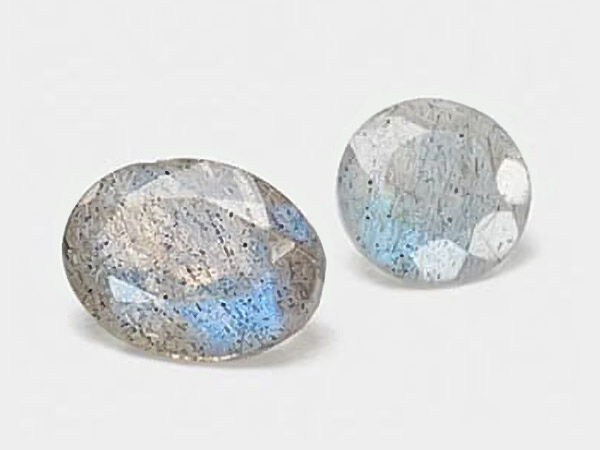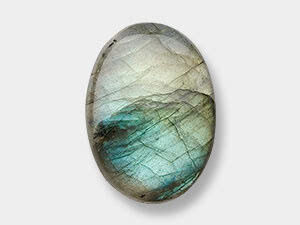Labradorite Meaning and Properties
Labradorite History
Labradorite is named for its discovery in Labrador, a province in Canada on the Isle of Paul. According to Inuit legend, a warrior saw the Northern Lights trapped in stone and freed some of them with his spear, leaving the rest behind to shimmer within labradorite. The Inuits revered it as a "fire stone" and used powdered labradorite to treat ailments.
First introduced to Europe in the 18th century by Moravian missionaries, labradorite quickly gained popularity. Though originally found in Canada, labradorite also occurs in Mexico, Russia and Finland. In addition to jewelry, it has been used in road construction, ceramics and glassmaking.
Watch this video and unearth the beauty and legend of labradorite. Discover the history of this stone, where it's commonly found, metaphysical properties and ideas for incorporating labradorite into jewelry designs.

What are the Metaphysical Properties of Labradorite?
Labradorite meaning often ties into spiritual protection and inner strength. This powerful gemstone is considered a guardian of the aura, shielding the wearer from negative influences. It is also thought to restore energy and support emotional healing, making it a favorite for those who tend to overwork.
With its color-shifting quality, labradorite is regarded as a stone of transformation, believed to enhance inner wisdom, willpower and self-worth. It’s also linked with the throat chakra, encouraging clear communication. Though not associated with a specific zodiac sign, labradorite is said to resonate strongly with Cancer.
What is Labradorite Made From?
Labradorite is a type of plagioclase feldspar mineral, with a chemical structure of 50–70% calcium and 30–50% sodium. Its most defining characteristic is labradorescence—the brilliant flashes of blue, green and gold that appear under light, caused by twinning within the crystal structure.
Spectrolite, a rarer variety, displays a fuller spectrum of color. These optical effects are caused by light refracting at different angles as it passes through internal layers in the stone.
- Mineral Information: Calcium sodium feldspar
- Chemical Composition: Na(AlSi₃O₈)Ca(Al₂Si₂O₈)
- Color: Grey to blue with green and blue flashes
- Hardness: 6 to 6.5 (Mohs)
- Specific Gravity: 2.69 – 2.70
- Refractive Index: 1.560 – 1.568
How Do You Clean Labradorite?
Labradorite is moderately hard but can be fragile due to its layered structure. Avoid ultrasonic cleaners, steamers, or high heat. Use mild soap, lukewarm water and a soft cloth to clean labradorite safely. To prevent scratches, store labradorite separately in a soft pouch or cloth wrap.
Many designers prefer labradorite for earrings or necklaces rather than rings or bracelets, which are more prone to impact.
Labradorite FAQ
Does the color in labradorite change based on the angle or light conditions?
Yes. Labradorite is famous for its unique optical effect called labradorescence, which causes vivid flashes of blue, green, gold, or even purple depending on the angle of light. This play of color shifts as the stone is moved, making each piece visually dynamic and one-of-a-kind.
Is labradorite durable enough for daily wear?
Labradorite has a Mohs hardness of 6 to 6.5, making it moderately durable for everyday wear. It's suitable for pendants, earrings, and occasional-wear rings, but it may show scratches or chips if worn daily in rings or bracelets. Careful handling and proper settings can help protect it.
Are there imitations of labradorite that one should be aware of?
Yes. Some imitation stones, such as coated glass or plastics, may try to mimic labradorite's flash, but they lack its natural depth and shifting color patterns. True labradorite will have a natural-looking base with iridescent flashes, not a surface coating. Always purchase from reputable sources to ensure authenticity.
What stones go well with labradorite?
Labradorite pairs beautifully with moonstone, black onyx, iolite, amethyst and pearls. Its cool tones and metallic flashes also complement silver, white gold, and gunmetal settings. In more vibrant designs, it can contrast strikingly with citrine, turquoise, or carnelian.
How should you store labradorite jewelry?
Store labradorite jewelry in a soft pouch or lined box, away from harder gemstones that could scratch its surface. Avoid high heat, sudden temperature changes and harsh chemicals. Clean gently with mild soap, lukewarm water and a soft cloth—never use ultrasonic cleaners.
Designing with Labradorite
With its luminous glow, labradorite makes a magical centerpiece in jewelry. Labradorite cabochons shine best in open-back settings that allow light to pass through, enhancing their vibrant flash. The gemstone pairs beautifully with sterling or antiqued silver.
Highlight labradorite’s play of color by matching it with complementary gemstones—green prehnite, jade, or emerald for green flashes; aquamarine, apatite, or blue sapphire for blue tones. Designers also love to pair labradorite with black onyx jewelry for bold contrast and elegance.
Labradorite meaning extends to designs intended to channel spiritual growth, transformation, or energy protection—making it a favorite for talismanic pieces and chakra bracelets.
A Few Design Inspirations to Get You Started
In this video, unleash your creativity with this enchanting labradorite gemstone bead tutorial, where glistening beads are strung on beading wire, framing a captivating metal fairy focal as the centerpiece, creating a spellbinding jewelry piece that dances with magic and fantasy!

Shop for Labradorite
**Please note that all metaphysical or healing properties listed are collected from various sources. This information is offered as a service and not meant to treat medical conditions. Fire Mountain Gems and Beads® does not guarantee the validity of any of these statements.
How did you like this resource? Your feedback helps us provide resources that matter to you most.
Copyright Permissions
All works of authorship (articles, videos, tutorials and other creative works) are from the Fire Mountain Gems and Beads® Collection, and permission to copy is granted for non-commercial educational purposes only. All other reproduction requires written permission. For more information, please email copyrightpermission@firemtn.com.

